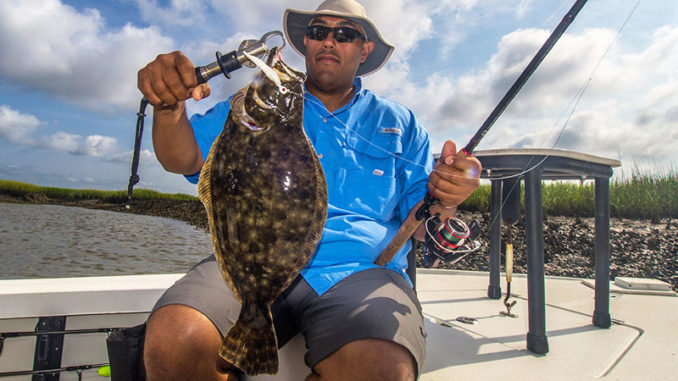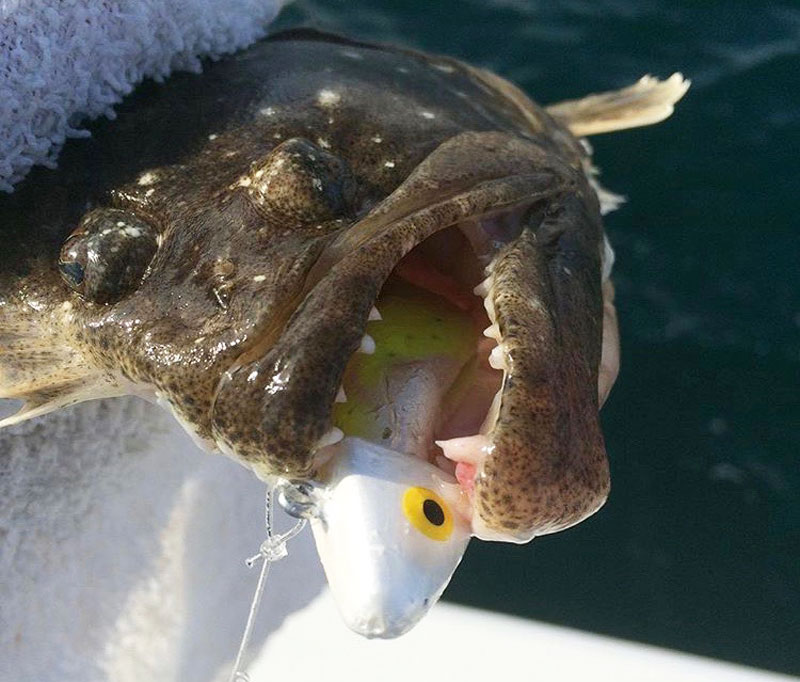
Upsize your artificial offerings and do battle with more doormat-sized flounder this summer.
As June arrives, anglers flood the estuaries along the Carolinas’ coastline in search of doormat-shaped beasts. The combination of warm water and abundant forage creates the perfect invitation for large schools of southern flounder.
The Carolinas are well known for producing big catches of America’s favorite flatfish, and a mud minnow fished on a Carolina rig is known as the most-reliable tactic. But for the pros in the flounder-pounding world, a live-bait rig is a thing of the past. It was ditched years ago for artificial options that produce bigger hauls in more ways than one. And not just any old plastic bait either. The true flounder pounders use strictly artificial lures and some real big ones.
Jot Owens of Jot It Down Fishing Charters qualifies as one of the North Carolina’s flounder pounders; he regularly catches doormat-sized flounder out of his home port of Wrightsville Beach, targeting structure with large artificial lures.
“Juvenile flounder congregate on sand bars, creeks with dropoffs and in open water along creek channels,” said Owens (910-233-4139). “The bigger fish are like red drum; they are more structure-oriented than the younger stock.”
Pay close attention to old docks with live oysters
Larger flounder are also found in smaller numbers and are often solitary. Docks, bridge pilings, oyster bars, bulkheads or any underwater structure can be a good location to find a large flounder. Owens fishes all of those kinds of places, but he prefers old docks along the ICW loaded with live oysters.
“Big flounder love structure, and the big ones will break their cover to get a big meal,” he said. “They aren’t going to waste energy on smaller baits in these cases. Bigger baits will bring bigger fish to the table.”

While he may not catch as many flounder, the size of the ones he catches more than make up for the lower numbers; he rarely has to measure one to see if it’s a keeper.
His secret for consistently catching big flounder can be spelled out in one single word: efficiency
“We must cover a lot of ground to consistently catch a heavy stringer of flounder, and efficiency is the key,” he said. “Working a jig across the bottom is more efficient than other traditional methods because it rides over structure and provides a realistic presentation. The more efficient you are, the better you will do, and a well-fished jig in heavy cover will produce plenty of big fish.”
Go big when flounder fishing
The second key to catching big flounder is a big presentation. Adult flatfish are efficient feeders. While they will eat smaller baits, they want a bigger reward for their efforts. The larger flounder have a tendency not to move until the perfect opportunity presents itself to ambush a meal.
“My go-to flounder bait for sizable flounder is the 6-inch Gulp Jerk shad. It’s a large bait, but the fish can easily see it, and the bigger fish have no issues taking it down all at once,” he said.
Owens uses a variety of other soft-plastic lures, including the new 5-inch Powerbait Grass pig, a bait with a paddle-shaped tail that provides extra action and vibration. Visibility is important to catch the attention of an adult flounder holding motionless on the bottom. The larger lures offer a clear message to the fish. Owens prefers pearl/white, chartreuse/pearl and other similar color combinations. One of his new favorites in the Grass Pig is the crazy chrome violet.
Use heavy jigheads
“It’s a clear-colored bait loaded with flecks of silver and purple,” he said. “It’s one of my new favorite colors because it is highly visible in a variety of water conditions, and the fish love it.”

A presentation along the bottom and near structure is the most productive. As a result, relatively heavy jigheads are preferred: 3/8- to ½-ounce sizes. Owens prefers to use an unpainted, round, 3/8-ounce jighead with a long-shank hook.
“I prefer the unpainted jigheads because I want the lure to get the look over the jighead,” he said.
For most anglers, a trip to the bait shop for six dozen mud minnows and enough hardware to build several Carolina rigs is the main plan for the day. While these anglers can catch plenty of flounder, the ratio of keepers to throwbacks is often less than desirable. For anglers looking for some real drag-testing foes should stock up on big plastics for some really big flounder.
No time to wait
For years, anglers targeting flounder have looked at their watches and started counting to 10 or20 as soon as they felt a bite.
Why?
Many fishermen believe that flounder slowly take in a bait, a little bit at a time, until the hook is well down their throat, and a good hookset is guaranteed.

For any angler who has ever watched a flounder eat in clear water, the slow take isn’t what actually happens. Similar to speckled trout and many other gamefish, flounder gulp their food into their mouths in a single motion, and then down the hatch a few seconds later.
Over the past two decades, many fisherman have used a 10-second count to make sure the bait was all the way. That came from setting the hook and coming up short with a mashed minnow missing scales. Guide Jot Owens has the answer for these shortcomings.
“Flounder don’t nibble the bait. They inhale it. People get confused on the smaller flounder bites. Large flounder; they get it all,” Owens said. “If you are using live bait or artificial lures, you should always set the hook immediately if you get a bite or feel dead weight. No waiting around for anything!”
There can be another disadvantage of waiting to set the hook. If the fish feels the sharp hook point inside its mouth, it can spit it out just as easily as it inhaled it. A quick hookset doesn’t leave any time for the fish to spit the bait back out.
To catch more flounder, always set the hook immediately after feeling the bite or a heavy feeling of deadweight.


